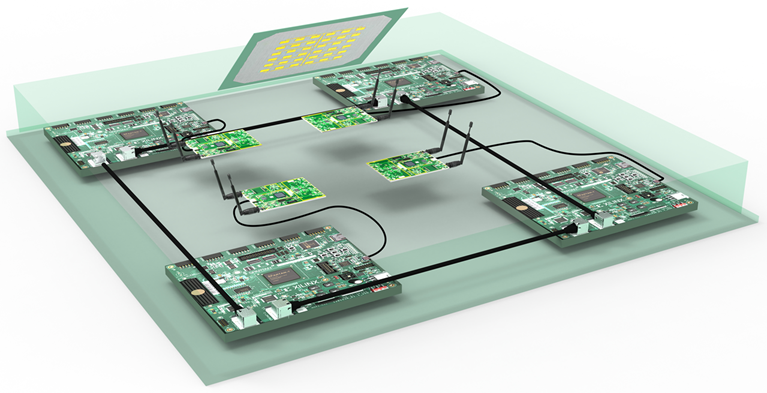EWiC: Emulation of Wireless Communication among Chiplets inside a Computing System
Domain specialisation (e.g., AI) coupled with skyrocketing manufacturing costs of chips led to a paradigm shift towards chiplet-based computing. However, the current Network-in-Package (NiP) is not suited for the increasing chiplet (CPUs, AI accelerators, etc.) count and their diverse communication needs. As a result, communication has become the main bottleneck to computing advances.
Wireless transmission can enable a one-hop communication with low latency parallelism. The wireless links can be reconfigured dynamically for demand-specific services. Finally, the native broadcast capability of wireless transmission will provide natural support for scalability. However, wireless communication is limited by the bandwidth. Hence, the ERC Starting Grant WINC explored via simulation combining wireless communication with the high bandwidth of wired connections, proving potential for >5× speedups.
In EWiC, we aim, for the first time, to emulate and demonstrate wireless communication among chiplets inside a computing system. The goal is to experimentally validate our simulation results, which have shown high speedups in multi-chiplet systems. Successful results will generate interest in the industry for further research and application in various domains, such as speeding up computation in pharma for new drug design. EWiC will thus help fully realise the trillion-euro potential of advanced computing, alongside immense social benefits and establishing EU leadership in this field.
The EWiC project will thus assess the commercialisation potential of our technology, engaging with key stakeholders such as chipmakers and end-users. Exploitation options including licensing, startup creation, or joint ventures, will be explored based on prototyping results and market entry considerations. Our IPR strategy will involve a thorough analysis to identify and protect the novel results of the project. We will additionally carry out a Freedom to Operate (FTO) analysis to ensure exploitability.



Website:
https://sites.google.com/view/erc-ewic
Project Type:
ERC Proof of Concept
Funding:
150K
Duration:
2024-2026
EWiC: Emulation of Wireless Communication among Chiplets inside a Computing System
Website:
https://sites.google.com/view/erc-ewic
Project Type:
ERC Proof of Concept
Funding:
150K
Duration:
2024-2026
Domain specialisation (e.g., AI) coupled with skyrocketing manufacturing costs of chips led to a paradigm shift towards chiplet-based computing. However, the current Network-in-Package (NiP) is not suited for the increasing chiplet (CPUs, AI accelerators, etc.) count and their diverse communication needs. As a result, communication has become the main bottleneck to computing advances.
Wireless transmission can enable a one-hop communication with low latency parallelism. The wireless links can be reconfigured dynamically for demand-specific services. Finally, the native broadcast capability of wireless transmission will provide natural support for scalability. However, wireless communication is limited by the bandwidth. Hence, the ERC Starting Grant WINC explored via simulation combining wireless communication with the high bandwidth of wired connections, proving potential for >5× speedups.
In EWiC, we aim, for the first time, to emulate and demonstrate wireless communication among chiplets inside a computing system. The goal is to experimentally validate our simulation results, which have shown high speedups in multi-chiplet systems. Successful results will generate interest in the industry for further research and application in various domains, such as speeding up computation in pharma for new drug design. EWiC will thus help fully realise the trillion-euro potential of advanced computing, alongside immense social benefits and establishing EU leadership in this field.
The EWiC project will thus assess the commercialisation potential of our technology, engaging with key stakeholders such as chipmakers and end-users. Exploitation options including licensing, startup creation, or joint ventures, will be explored based on prototyping results and market entry considerations. Our IPR strategy will involve a thorough analysis to identify and protect the novel results of the project. We will additionally carry out a Freedom to Operate (FTO) analysis to ensure exploitability.


